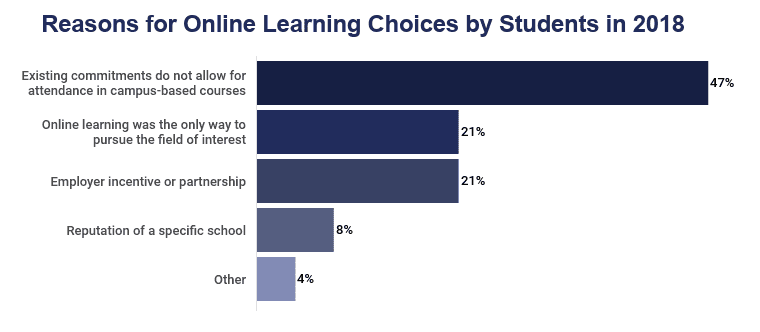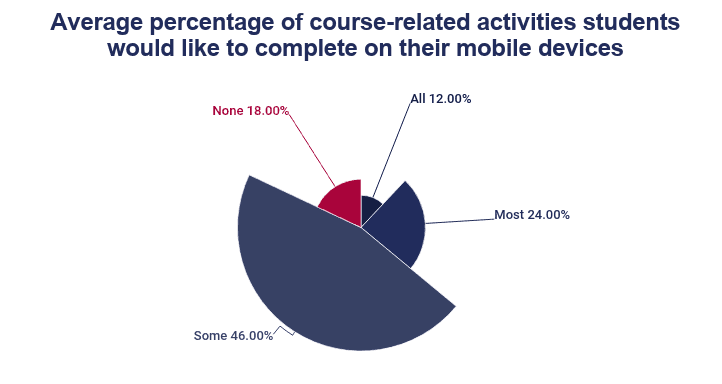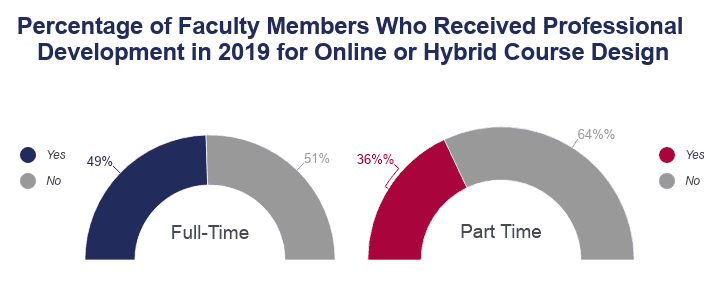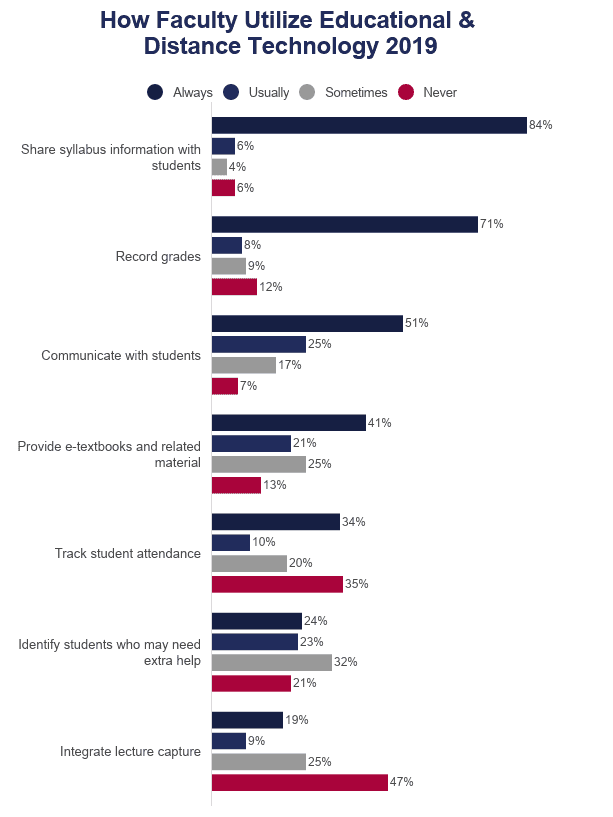Online Education Statistics
| Letter Grade / Descriptor | Numerical Range | |
|---|---|---|
| A | Excellent | 90-100 |
| B | Good | 80-90 |
In 2017, a total of 19.7 million students enrolled in courses at degree-granting postsecondary institutions. Of these, 6.6 million students enrolled in some form of distance education/online learning courses.
- 5.5 million undergraduate students
- 3.2 million (19.5%) students took least one but not all of their courses online
- 2.2 million (13.3%) students enrolled in exclusively distance education/online courses
- 1.4 million post-baccalaureate students
- 274,211 (9.1%) students took at least one but not all of their courses online
- 868,708 (28.9%) students enrolled in exclusively distance education/online courses
- During the fall 2017 semester, 3.1 million (15%) students enrolled exclusively in distance education courses:
- 142,840 were outside the United States
- 1.1 million were outside the state of the school where they enrolled
- 1.7 million were within the same state of the school where they enrolled
- The location or state was unknown for 33,610 students
General Statistics
- Public institutions use distance education and online learning technology compared to than private institutions.
- Most distance education students are undergraduate
- In 2017, 4.6 million (32%) students in public institutions participated in distance education in some capacity:
- 3 million students enrolled in at least one distance education course
- 1.6 million enrolled exclusively in distance education courses
- In contrast, only 1.1 million students at private nonprofit institutions enrolled in distance learning during the same year:
- 392,155 students enrolled in at least one distance education course
- 788,407 students enrolled exclusively in distance education courses
- 47% of students chose online degree programs in 2018 due to other commitments making it difficult to attend class on campus
- 21% of students chose online degree programs in 2018 because that was their only means of obtaining a degree in their field of interest
- In 2019, only 48% of 4-year schools increased their budgets for online learning compared to 41% of 2-year schools
- 87% of students use their mobile devices to look for online study programs and 67% utilize mobile devices to complete online course work

Distance/Online Learning: Instructional style and format
Distance education can take many forms. The most common are:
- Fully online: Active instruction, testing, assignments, and discussion takes place online
- Blended or Hybrid: Between 25-50% of instructions, assignments, and discussion takes place online
- Students study course material outside class and utilize classroom time to reinforce learning, ask questions, and interact with their instructor
- Face-to-Face Web Enabled: Students “meet” virtually with their instructors (and other class members) via video chat or teleconferencing
- Emergency remote teaching: shifting of face-to-face, blended, or other courses to a fully online format in the event students or faculty are unable to come to campus.
Distance/Online Learning: Components of Online Courses
Most online courses utilize a Learning Management System or LMS. Some of the most popular LMS platforms in higher education include Moodle, Blackboard, D2L, and Canvas. Within these platforms, students can access a course. An instructor will upload their content within a course shell. This content is either prerecorded (asynchronous) or real-time (synchronous). Instructors can utilize their LMS to assign work to students, report grades and outcomes, and lead discussions.
In 2018, the most important class activities for most students in distance learning were:
- Videos and Powerpoint presentations from the instructor- 58% of students felt these were very helpful, compared to 3% who did not use them
- Textbook/written materials- 52% of students felt these were very helpful, compared to 3% who did not use them
- Written assignments- 51% of students felt they were very helpful, compared to 3% who did not use them
- Quizzes- 49% of students felt they were very helpful and 4% did not use them
- Interactive media- 46% of students felt they were very helpful, compared to 9% who did not use them
- Discussion boards- 43% of students felt they were very helpful, compared to 3% who did not use them
- Third-party videos- 37% of students felt they were very helpful, compared to 6% who did not use them
- Synchronous sessions-33% of students felt they were very helpful, compared to 17% who did not use them
In a time when fees and books contribute disproportionately to the cost of college education, 61% of students are amenable to an online learning program that is textbook-free compared to 4% who would not consider it.
Much of modern life takes place on mobile devices and the importance of mobile-friendly online learning only grows. At least 79% of students completed some coursework on their mobile devices.

Distance/Online Learning: Faculty Experience
- In 2019, 46% of faculty members said they have taught an online course for credit compared to 39% in 2016
- In 2019, 38% of faculty members used a blended or hybrid course format including both online learning and face-to-face instruction
- 41% of instructors teaching online have used distance learning technology for less than 5 years, and less than 25% taught online for at least 10 years
- College administrators are more likely to endorse distance learning than faculty.
- Just under 70% of instructors teaching online built their own courses in 2019, compared to 17% who utilized courses built by an instructional designer
- 14% who utilized courses another faculty member had designed
- 67% of faculty members received professional development for designing blended and online courses
- 39% utilized an instructional designer to revise or build an online course
- Most instructors do not support the usage of external vendors for online course delivery to students
- In 2019, 39% of faculty members indicated they supported increased usage of technology in education, compared to 29% in 2017
- In 2019, 60% of faculty members feel that academic dishonesty is more prevalent in online teaching vs. face-to-face settings compared to 39% who feel it occurs equally in both situations
- Full-time faculty members were more likely to have completed professional development and training for designing online or hybrid/blended courses online:


Distance/Online Learning: COVID-19 Impact
(June 2020 Update for High School Grads Considering College)
4-Year institutions are seeing an average of 6-8% decline in Fall 2020 enrollment as of June 15, 2020
Prospective students and returning students do not feel the costs for online tuition should not be as high as in-person classes:
Parents ranked quality of remote instruction students were presently receiving as 5.6 out of 10. Concerns included:
- Poor content
- Little collaborative learning
- Inconsistent instruction
- Little to no access to professors and teaching assistants
- Poor instructor preparation
- Limited technical knowledge by professors
Among high school seniors who were intending to enroll in a 4-year institution in Fall 2020 before March 1 and COVID-19:
- 11% had decided they were no longer planning to enroll in college for Fall 2020
- 8% indicated their change in plans was due to the COVID-19 pandemic
- 3% indicated their change in plans was due to other reasons
- 53% indicated their family’s financial situation had been affected because of COVID-19
- 44% were unlikely to change their minds about which college they would attend
- 24% indicated they were likely to change their minds about what college to attend because of COVID-19
- Among undecided high school seniors unsure of which school they would attend:
- 28% indicated COVID-19 was not influencing their college choice
- 34% indicated COVID 19 was influencing their college choice
- 40% of high school seniors who have decided on an institution for Fall 2020 indicate they are not receiving adequate information about how COVID-19 will affect enrollments
(June 2020 Update for Current College Students)
Among current college students (undergrad) who were enrolled at 4-year institutions before March 1 and COVID-19:
49% indicated their family’s financial situation had been affected by COVID-19
- 41% of college students indicate their opinion of their current school has worsened after the COVID-19 outbreak
- 26% indicate their institution’s communication with them about the pandemic has been fair to poor
- 67% feel their opinion of their current institution has worsened due to the level of communication about the pandemic
- 37% indicate they feel their institution’s handling of the pandemic is poor to fair
- 97% of college students have switched to online instruction
- 63% indicate the online instruction received is worse, compared to in-person instruction
- 31% indicate it’s about the same
- 5% feel it’s better
- 62% indicate they are highly likely to attend the same school next term
(April 2020 Update)
The COVID-19 pandemic underscores the importance of improving the quality of distance learning for higher education. Some general statistics as of April 2, 2020:
Estimates show 3,278 higher education institutions and 22.3 million students are impacted. For instance:
- 98% of institutions had moved the majority of in-person classes online
- The University of Washington was the first major university to close on March 7, moving classes and exams online for nearly 50,000 students
- 95% of institutions suspended travel for faculty & staff
- 93% of institutions implemented work-remotely policies for staff
- 43% of institutions had invested in new online learning resources
- As of April 2, the top immediate concerns of college and university presidents were:
- Students’ mental health- 92%
- Employees’ mental health- 88%
- Short-term financial costs (unbudgeted)- 87%
- Accelerated rates of student attrition- 85%
- Accessibility to online learning platforms/tools- 76%
- Faculty readiness for online learning- 75%
- Technological readiness for online learning- 57%
- Longer-term issues university administrators are concerned with include:
- Overall financial stability- 89%
- Decline in future enrollment- 88%
- Ability to afford/employ staff/faculty- 81%
- Demands for room/board reimbursement-62%
- Demands for tuition reimbursement- 55%
- Decline in international student enrollment- 49%
Concerns for the future:
- As of April 2, college and university presidents felt that the level of challenge at their institutions associated with moving face-to-face classes online included:
- Maintaining student engagement- 81%
- Training faculty less familiar with teaching online- 75%
- Ensuring student access- 69%
- Ensuring high academic standards- 50%
- Availability of technology- 50%
- Faculty buy-in- 22%
- As many as 70% of students are more likely to choose local or less-expensive schools
- Average enrollments for the summer 2020 semester project a 15% to 35% decline compared to 2019 enrollment numbers
COVID-19 Changes to Distance Learning & Accreditation
In March 2020, the CDC (Centers for Disease Control and Prevention) issued guidelines to institutions of higher education. Guidelines for college administrators included the utilization of alternative teaching methods. These are primarily online and distance learning.
Accreditation requirements are temporarily waived for institutions shifting in-person instruction to online learning formats. This flexibility is limited to courses interrupted by COVID-19.
- The flexibility in distance learning cannot be applied to courses that rely on clock-hours for licensure
- Institutions must utilize at least one type of technology, such as email, to communicate with students, provide instructional materials, and require students to submit work electronically
- Colleges can utilize temporary consortium agreements with other colleges to allow students to complete work at other institutions but be awarded the credit at their home institution
- Students can take a leave of absence, and the institution must allow the student to complete their coursework
- However, if the student doesn’t return within 180 days to complete the program, the school must return Title IV funds
- Institutions can reduce the length of the academic year
COVID-19 Impact on American students studying abroad & international students
- Students recalled from travel-abroad programs or other learning programs may complete courses on a non-standard term schedule
- Distance learning approved for students enrolled in US institutions but participating in study-abroad programs where the foreign school is either part of a consortium or has a written agreement with the student’s home US institution
- Flexibility for distance learning isn’t possible for foreign schools enrolling US students receiving Title IV HEA assistance
- 46% of institutions offered independent or remote study options for foreign students who were unable to come to campus for class due to travel restrictions
COVID-19 Impact on student financial aid and loans for online learning
- On March 27, 2020, the CARES Act provided a forbearance for federal student loan borrowers:
- Payments for federal loans will stop from March 13, 2020 through September 30, 2020
- The interest rate is set to 0% for the following federal student loans:
- Defaulted/nondefaulted Direct Loans
- Defaulted and non-defaulted FFEL Program Loans
- Federal Perkins Loans
- FFEL Program and Perkins Loans owned by commercial lenders not eligible for the benefit as of March 26th, 2020
- Additionally, other private loans aren’t covered by the CARES Act
- Students working a Federal work-study job may or may not be permitted to work remotely, depending on the school
- Students must participate in course work online if their college moved classes to online learning/distance learning format in order to continue to qualify for financial aid
- The Higher Education Emergency Relief Act (HEER) provides $13.9 billion in funding to affected institutions:
- Institutions must spend 50% of funds on emergency student financial aid, the remainder on other expenses including the transition to distance education
- $12.5 billion distributed to Title IV-participating 2 and 4-year institutions calculated as follows: 75% on FTE (Full-time equivalent) Pell Grant recipients and 25% on FTE non-Pell Grant recipients
- Students enrolled exclusively in online distance education courses prior to the pandemic are excluded
COVID-19 Impact and Foreign Students
- International students contributed nearly $41 billion to the US economy in the 2018-19 school year
- Additionally, international education is the fifth-largest service sector export in the US
- Nearly 458,000 jobs were created or supported by foreign students in 2019
- Marking the third straight year of decline, 2019 saw a 0.9% decline in foreign student enrollment
- Since fall 2016, new foreign student enrollment decreased 10.8%
COVID-19 Pandemic-Highlighted Inequality
- The performance gap between demographic groups worsens with online learning
- Equity-related efforts by schools include issuing students without access to technology digital devices such as laptops, tablets, mobile hotspots, and other items
Distance/Online Learning: Types of Programs
While most students enroll in distance learning for degree programs, there are other kinds of programs available online.
- 84% of undergraduate students enrolled in degree programs compared to 16% enrolled in certificate or licensure program
- 77% of graduate students enrolled in a degree program compared to 23% enrolled in a certificate or licensure program
The most popular field of study in online learning is business. However, as the diversity of programs and online offerings has expanded, other fields of study are increasing in popularity.
- In 2018, the most popular undergraduate programs online were
- Business- 23%
- Health & Medicine- 19%
- Computers & IT- 13%
- Social Sciences, Criminal Justice & Law- 11%
- Arts & Humanities- 10%

Distance/Online Learning: Student Satisfaction
- In 2018, 23% of students had concerns about the quality of instruction they would have in distance learning education, compared to 32% who had no concerns at all. In addition:
- 18% were concerned about how an online degree might be perceived by prospective employees
- 17% were concerned about a lack of interaction with classmates and instructor
- 9% were concerned about the challenge of learning new technology and software
Online classes are convenient for students who have more challenges and external commitments. For example, distance learning makes it possible for students to take courses not available to them where they live. Additionally, distance learning can teach students how to survive in a technology-oriented, globalized society. Furthermore, some universities such as the Massachusetts Institute of Technology require students to take online courses as a prerequisite requirement for certain programs.
- 85% of online students (undergraduate and graduate) who previously took both face-to-face and online courses felt their distance learning experience was the same or better compared to a classroom-based course:
- 37% felt distance learning was better than face-to-face instruction
- 48% felt distance learning was about the same as face-to-face instruction
- 15% of students did not feel their online courses were as effective
- Graduate students were more likely to indicate their online experience was better than face-to-face instruction:
- 42% of graduate students preferred it compared to 30% of undergraduate students
Distance/Online Learning: Challenges
However, distance learning can present more challenges for students who are not as well prepared. This is particularly evident in for-profit schools that enroll high numbers of low-income students. Additionally, there are some courses such as mathematics that have abysmal completion rates, whether taught online or face-to-face. Unfortunately, vulnerable populations may fare even worse in an online course than they might in a classroom setting.
- Completion rates for some students can be as much as 22% lower than for students in face-to-face courses
- Performance gaps exist among certain demographics taking courses online, including students with lower GPAs, male students, and students of color
Institutions face different challenges with distance learning. In 2018 they included:
- 69% indicated marketing new online programs and meeting recruitment goals
- 59% indicated meeting cost/management demands required by online programs
- 34% indicated making online programs profitable
- 16% indicated utilizing third-party content providers/designers and choosing content
- Finally, 4% had concerns regarding resistance by faculty to use of technology to support online instruction and students, maintaining the same rigor and content quality found in face-to-face instruction and high expectations
Summary:
Most students who enroll in online classes do so because full-time enrollment in the classroom face-to-face instruction is not possible. Most online learning students are undergraduate students at public institutions. Typically, online courses utilize a Learning Management System (LMS) such as Moodle, Blackboard, D2L, or Canvas. Part-time faculty were less likely to have had training or professional development for distance learning. Additionally, less than half of higher-education faculty had taught an online course in the last year. Most students studying online are pursuing programs in business, health sciences, and computer science.
Sources:
- The Best Accredited Online Colleges of 2020
- The Condition of Education 2019
- Online College Students 2019
- Share of online college students by distance from university US 2019
- Opinions of online college students on quality of online education US 2019
- Coronavirus and Forbearance Info for Students, Borrowers, and Parents
- COVID-19 (“Coronavirus”) Information and Resources for Schools and School Personnel
- Losing Talent 2020: An Economic and Foreign Policy Risk American Can’t Ignore (March 2020)
- Performance Gaps between Online and Face-to- Face Courses: Differences across Types of Students and Academic Subject Areas
- Online schooling: Who is harmed and who is helped?
- The COVID-19 Survey of College Presidents
- COVID‐19 Effects on US Higher Education Campuses
- Professors’ Slow, Steady Acceptance of Online Learning: A Survey
- Online Course Design: A Review of the Canvas Course Evaluation Checklist
- American Council on Education Simulates Distribution of CARES Act Emergency Funds
- Coronavirus Public Health Emergency Underscores Need for Department of Education’s Proposed Distance Learning Rules
- COVID-19 Higher Education
- United States Census Bureau Education TablesThe Integrated Postsecondary Education Data System
- Some parents won’t pay or are unsure about children enrolling online for the fall
- Taking Colleges Online: How Smart Institutions and Their Leaders Can Approach Online Education Now and in a Postcoronavirus World
- Higher Ed Resources
